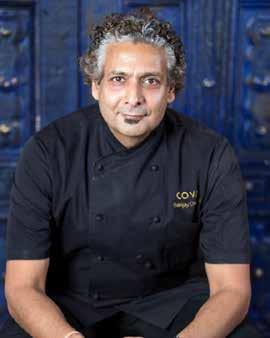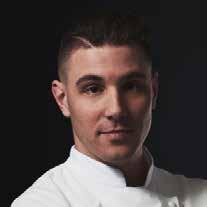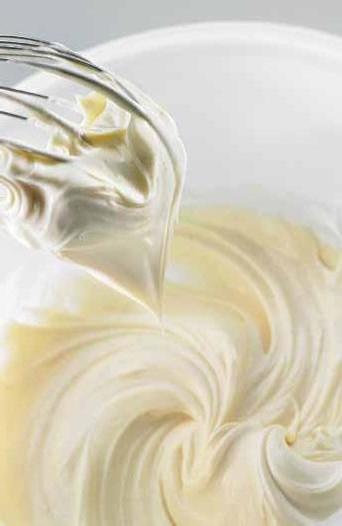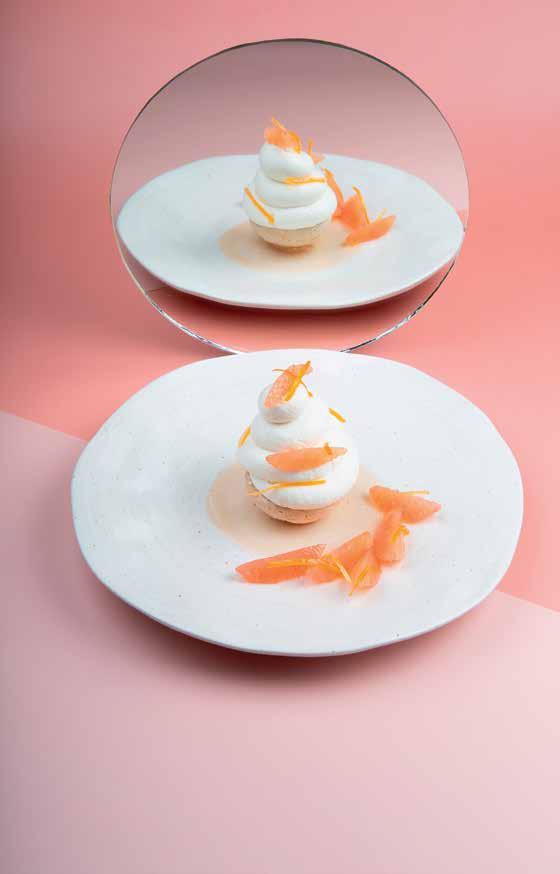
11 minute read
A DAY IN THE LIFE OF
A DAY IN THE LIFE OF A CULINARY DIRECTOR
Inside COYA Culinary Director Sanjay Dwivedi’s daily routine
Advertisement
7:30AM – I have a different schedule in Dubai compared to London, starting my day with exercise. I do Bikram yoga, practiced in a room heated to 40 degrees. I’m very fortunate that I've found a yoga studio near my hotel. I've been going there three times a week and it takes me about half an hour to walk to the studio, arriving 15 minutes early. My main goal is to loosen up and prepare me for whatever the day might have in store. It leaves me feeling that I can move through the day feeling mentally and physically strong. I started doing yoga more, during the lockdown in London, and it’s become a nice way to start my morning.
9:00AM – After yoga, I walk down to the hotel. I'll go down the pool and relax before I shower and prepare to leave. I changed my eating and drinking patterns since the lockdown. These days, I’ve been doing intermittent fasting as well. I’m only having black coffee, which is why I don’t go to cafes as I would usually do. I take my decaf espresso probably at the hotel or when I get to the restaurant and have oat milk with it. Coffee isn’t as big as it used to be with me, but I found myself sleeping better now because I don’t have much caffeine in my system.
10:30AM – I head to COYA Dubai and spend the late morning catching up with the staff to see what’s going on for the day. I don’t manage the kitchen of any of the restaurants now, because it would be difficult to manage eight kitchens across different continents at once. I’m glad to have been able to empower and pass on 6:30PM – I'm part of the staff dinner and briefing for the evening service around this time. It’s always so energetic, it’s something we’ve done consistently at COYA every day since we opened. I don’t get as involved as much as before; I just like listening now. COYA is like my second baby, so I love seeing and hearing how it’s being looked after so well by different people. I think I’ve got the best job in the world right now to be able to just move around and see everyone doing their jobs - it just works out perfectly.
9:00PM – Depending on the mood as well, I like to go to the Bar & Lounge and try a couple of concoctions from the guys and see what’s new. My beverage consumption has been very low recently as I know I’m not getting any younger and I don’t want to overindulge.
10:30PM – Once it’s getting late and the restaurant is slowing down slightly, I prepare to go home. I like to walk back to the hotel and listen to music. I make sure to catch up with my kids on videocall. Yesterday, I was talking to one of the twins and then today I’ll talk to the other. I don’t ask them what they did at school because kids don’t like that - I ask about their day and I tell them about mine.
12:00AM – I check out Netflix quickly before bed, even though I don’t watch TV so much when I’m travelling. I recently finished The Last Dance on Netflix, which I think is just the best docuseries. Michael Jordan was sort of my childhood hero growing up, so to me, it was mind blowing to watch. I always have a hot shower to end the day.
my knowledge to these young chefs and see how they apply that in the kitchen.
12:00PM – For lunch, I sit down with COYA’s Executive Chef in the Middle East, Chef Ben, and our Head Chef in Dubai, Chef Eric, to do a tasting of a couple of new dishes we may want to add on the menu and talk about how we can improve them. For me, the only way a chef will find out how good your food is, is by sitting down, away from the kitchen, with nobody asking you questions, and just eating the food.
2:00PM – In the afternoon, I give my wife a call just to see what’s been going on back home. Maybe I’ll go around the restaurant after that and speak to COYA’s guests and members. There was a member here yesterday who also came the day before, and I made some food for him. It’s nice to make people feel comfortable and special. I like to treat our guests the same way I would like to be treated when I go to a restaurant.
4:00PM – I also like to go outside and visit COYA’s next door neighbours and speak to their chefs about the latest industry news. I think it's always good to know what everybody else is up to. I don’t really have a strict schedule when I’m in Dubai.
5:00PM – Maybe I’ll have a meeting with the big boss and see where we’re at and what’s happening at the restaurant. I come to Dubai only twice a year and have press opportunities and photoshoots lined up, so I take time to do these while I’m here.

Taste of Italy
Nicknamed The Glimmer Twins by Roberto’s in-house team, Head Chefs Danilo Valla and Giovanni Cortese, bring forth cooking traditions and techniques from two distinct gastronomic cities in Italy. Find out how these chefs combine their skills to launch new concepts
How did the both of you get started in culinary?
GC: I learnt to cook by myself while my parents were at work. I started to cook daily and saw that I actually liked it and developed an interest in cooking. I then went on to work at a local pizzeria, perfecting my newly acquired skills.
DV: My parents operated restaurants. I grew up in the industry, so I always wanted to be a part of it. I worked behind the bar and thought that I’d be a mixologist but found that I wasn’t really attracted to service and waiting tables. I actually preferred working in the kitchen. So, I went to culinary school and that’s where my career began.
Tell us about the newly launched concepts at Roberto’s
GC: I conceptualized the Italian Fish Market (fresh fish display in Roberto’s) and liaise with suppliers to always stock premium

Danilo Valla

Giovanni Cortese
The both of you are from completely different areas of Italy. How does this influence your cooking?
GC: I’m from the south of Italy (Naples) which is heavily influenced by the region’s specialty of seafood and lemons.
DV: And I’m from the mountains (Alba region) where there’s a big emphasis on meat and produce such as truffles and olive oil. When we combine our skills and tastes, we are able to create unique flavours and dishes.
products that are fresh and exquisite. For example, Blue Lobsters, Carabineros Red Prawns, Sea bream, Wild Brown Crab, Dover Sole and/or Scorpion Fish. These are served with a side dish of Italian Caponata; a Sicilian dish of chopped, fried aubergine and vegetables, seasoned with olive oil, tomato sauce, celery, olives and capers, in an agrodolce sauce. Diners can choose the cooking style of this fish, from charcoal grill to crust salt, crazy water or with pasta.
DV: I recently introduced the Italian Butcher activation – a Tuesday night meatinfluenced dining experience, serving up premium cuts from Australia, Canada, Ireland and Japan. Diners can select their cut from the impressive meat display, which will then be cooked in the charcoal grill Josper oven. These premium cuts of beef, lamb and veal are available from AED250 to AED1,000.
Can you name a few dishes in which your influences are evident?
GC: Yes, the Astice alla Griglia (Chargrilled Canadian lobster, mix grilled vegetables), Branzino al Sale 420 (Oven-baked sea bass in sea salt crust) and Polpo (Slow cooked roasted octopus, artichoke, cacio e pepe sauce).
DV: My influences are noticeable in the Grilled Heritage Angus Tenderloin Chateaubriand (500g), Grilled Australian Black Wagyu Tenderloin (250g, grade 4/5), and finally, the Surf and Turf of Wagyu Tenderloin and Blue Lobster or Tiger Prawns - a perfect combination of flavour and texture between the sweet meat of the shellfish and mouthwatering sensation of the Wagyu beef.
Where is the produce sourced from?
GC: Our produce is part sourced from Italy, like our cheeses and olive oils. Dry pasta (spaghetti, calamarata) is artisanal pasta from Napoli, Italy. Fresh fish like red prawns, rock lobster and many other kinds are also brought in from Italy (Sicily and Sardegna), alongside lemon, some fresh fruits and vegetables.
DV: Here locally, we work with Italian cheese makers that produce and supply burrata. We also work with a local honey maker.
Now that we know about the new concepts, do you have any kitchen secrets?
GC: Everything is homemade in Roberto’s kitchen. From pasta to bread, pesto and the pistachio ice-cream (Gelato Oro). The gelato is one of our bestsellers and a signature special at Roberto’s. If you see it elsewhere, you know where the inspiration stemmed from.
DV: It is definitely one of its kind in the city. The ice-cream is topped with a generous drizzle of olive oil. Our chefs discovered this technique and flavour by fault, a couple of years ago, at our former sister venue Roberto’s Abu Dhabi. The olive oils’ texture and flavour smoothen the palate - it’s incredible!
GC: It’s the most popular desert ever requested. It’s sought-after, Instagramworthy and talked about by diners and chefs. A total success!
Future plans for Roberto’s.
GC: Roberto’s are expanding into three new countries across the GCC in 2021, 2022 and 2023, and we’re responsible for creating the menus and execution. In October 2021, we will open Roberto’s Amman, Jordan, operated by Marriott International within their newest development, The Ritz-Carlton Hotel in Amman.
DV: We are quite excited about this. We’re also opening Roberto’s in Qatar and Oman. The two outlets will be sited within The St. Regis Marsa Arabia Island, The Pearl in Doha, Qatar, and at The St. Regis Al Mouj Muscat in the Sultanate of Oman. Outside the GCC, we’re all set to open up our summer venue this June, in Montenegro. This will be our third season there!
Rise to the top with French Cream
In pastry and other branches of the culinary arts, there is no denying that cream is an essential ingredient. As a cooking element, it adds an incredible depth of flavor.
European dairy cream, especially French cream, enhances the flavor of all preparations. It has an unparalleled melt in the mouth, and its softness on the palate is uniquely smoothing and comforting. No matter the level of the cooking skills, anyone can incorporate French cream to a range of dishes, from savoury to sweet.


Nina Métayer
is a French Chef awarded twice as best pastry chef in 2016 and 2017.
For her dessert, she put together a fruit-forward dish and whipped up a creamy grapefruit meringue, then completed the plate with vanilla tonka chantilly.

Creamy, tangy grapefruit meringue

500g Egg whites 250g Confectioner’s sugar
250g Almond powder 500g Caster sugar Using an electric mixer, beat the egg whites into peaks with the caster sugar and add the sifted powders. Form pretty, smooth balls with the mixture and bake them on a baking sheet for 30 min at 160° C then dry them at 100° C. Let them cool then scratch them with a dremel.
GRAPEFRUIT AND VANILLA SORBET
630g Water 1470g Grapefruit juice 5 Vanilla pods
210g Sugar 108g Glucose spray 12g Stabilizer Heat the water to 50° C. Add the mix of sugar, glucose spray, and stabilizer. Add the vanilla and bring to a boil. Let it cool, then mix with the grapefruit juice. Let this mixture rest for 12 hours then use an ice cream machine to create the sorbet.
GRAPEFRUIT JELLY
2100g Grapefruit juice / 200g Prepared gelatin / 3 Vanilla pods
Heat the grapefruit juice and mix in the gelatin. Spread onto a greased pan and let it set in the refrigerator for 2 hours before slicing.
TONKA VANILLA WHIPPED CREAM
5L Liquid cream 1kg Mascarpone 210g Confectioner’s sugar 1 Tonka bean 3g Vanilla pod
Grate the tonka bean and mix it with liquid cream. Let it infuse, cold, for 3 hours then strain. Combine with the sugar and mascarpone and whip it with the electric mixer.
CANDIED GRAPEFRUIT ZEST
5 Grapefruits / 500g Grapefruit juice / 500g Caster sugar
Remove the peel from the grapefruit making sure to discard all of the pith. Slice the zest into a thin julienne, blanch three times, then simmer in the syrup for around 15 min.
ASSEMBLY
30 pieces Grapefruit 200g Marzipan
Dried grapefruit zest to taste Dried vanilla powders to taste Use a cookie cutter to cut the grapefruit jelly into circles and place them in the center of the plate. Place a dab of marzipan on top. Stick on the meringue shell. Garnish with grapefruit sorbet. Arrange a few fresh grapefruit slices. Use a 12mm wide plain tip pastry bag to create a pretty swirl of tonka whipped cream. Decorate with dried, candied zests, fresh grapefruit segments, and dried vanilla powder...




